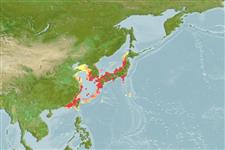Common names from other countries
Environment: milieu / climate zone / depth range / distribution range
Ecologia
marino demersale; non migratori; distribuzione batimetrica 0 - 30 m (Ref. 6205). Subtropical; 45°N - 21°N, 116°E - 149°E (Ref. 6205)
Northwest Pacific: Japan, Korea, China, and Taiwan. Possibly to the Philippines. Commonly misidentified as Sillago sihama.
Size / Peso / Age
Maturity: Lm ? range ? - ? cm
Max length : 30.0 cm TL maschio/sesso non determinato; (Ref. ); common length : 22.0 cm SL maschio/sesso non determinato; (Ref. 6205)
Spine dorsali (totale) : 12; Raggi dorsali molli (totale) : 21 - 23; Spine anali: 2; Raggi anali molli: 22 - 24; Vertebre: 35. Swim bladder with anterior projecting extensions and a single posterior extension. Body is greenish gray above, the dorsal part of the head being the darker, and whitish below. The fins are mostly hyaline; the membrane between the first to the third dorsal fin spines with minute dark brown dots; the margins of the dorsal fin with a few dark brown spots. The caudal fin with dark margins.
Occur in bays on shallow sandy flats. Maximum size is over 30 cm (Mark Donachy, pers. comm., 2001). Oviparous (Ref. 205). Greatly esteemed for its delicate flavor (Ref. 6205).
Life cycle and mating behavior
Maturities | Riproduzione | Spawnings | Egg(s) | Fecundities | Larve
McKay, R.J., 1992. FAO Species Catalogue. Vol. 14. Sillaginid fishes of the world (family Sillaginidae). An annotated and illustrated catalogue of the sillago, smelt or Indo-Pacific whiting species known to date. Rome: FAO. FAO Fish. Synop. 125(14):87p. (Ref. 6205)
IUCN Red List Status (Ref. 130435)
CITES (Ref. 128078)
Not Evaluated
Threat to humans
Harmless
Human uses
Pesca: commerciale; Acquacoltura: probabile utilizzo futuro
Strumenti
Warning: mysqli::__construct(): (HY000/1040): Too many connections in /var/www/html/includes/speciessummary.lib.php on line 2104
Can't connect to MySQL database fbquizv2. Errorcode: Too many connections
